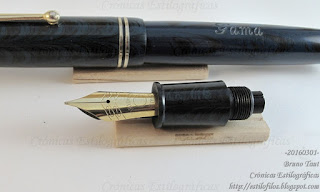In the 1990s he worked for the Italian company Visconti, founded in 1988 in Florence, making some of the early celluloid pens of the brand. Such is the case of the following example.

The monotone 18 K gold nib. It reads "VISCONTI / 18 K - 750 / FIRENZE / M". The inscription on the clip: "FIRENZE VISCONTI / ITALY RAGTIME".
It is a Visconti Ragtime (thanks, Peaceable Writer) from the second series (aka Ragtime II, with a monotone 18 K nib) in production between 1994 and 1999. It is made of cellulose nitrate sheet, rolled and welded.
Some argue that this approach –rolling and welding—is superior to turning a solid rod because the final cylinder is less likely to shrink and contract over the years. The obvious side effect is the existence of a welding like on body and cap. The flat ends of the Ragtime are, in actual terms, lids to the rolled cylinder and are welded to it, as can be seen on the following picture.
These are the dimensions of this piston filler:
Length closed: 139 mm
Length open: 124 mm
Length posted: 165 mm
Diameter: 12 mm
Weight: ca 19.7 g (inked)
Kato’s engagement with Visconti ended around 2000. Since the mid 1990s, he and his wife had started making pens in Japan for the Japanese market. This was his last endeavour—he passed away in 2010.
My thanks to Mr. Shimizu.
Gama Forever – Montblanc Racing Green
Bruno Taut
Nakano March 1st, 2016
etiquetas: Visconti, Kato Seisakusho
Bruno Taut
Nakano March 1st, 2016
etiquetas: Visconti, Kato Seisakusho



























